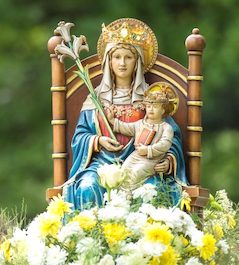Our Lady of Walsingham
- A PRIEST OF THE ORDINARIATE
The traditional story of Walsingham tells how, in 1061, during the reign of Saint Edward the Confessor, Richeldis de Faverches, the lady of the manor of Walsingham Parva, saw a vision of the Blessed Virgin Mary.

Richeldis was taken in spirit to Nazareth where Our Lady told her to build a shrine in honour of the Holy House of the Annunciation. The workmen had difficulty in erecting such a house, but after Richeldis had spent a night in prayer, the next morning the Holy House was found to be complete. It was believed that Our Lady, assisted by angels, had moved the House to a site of her choosing, by which a spring of water, with healing properties, was found. In vision, Our Lady promised Richeldis, 'All who are in any way distressed or in need, let them seek me in that little house you have made at Walsingham. To all that seek me there shall be given succour. And there at Walsingham in this little house shall be held in remembrance the great joy of my Salutation when Saint Gabriel told me that I should, through humility, become the Mother of God's Son'.
Many other stories were attached to the beginnings of the shrine by later generations, but the fact is that Richeldis built a small wooden shrine, and pilgrims began coming to Walsingham. People found that God and heavenly things seemed real to them there. They found that they prayed better and that prayers were answered. They believed, too, that wonderful healings and blessings came to them when, with faith, they used the waters of the holy well. It was a simple age, but then, as now, God gives great blessings to the simple and the humble.
All over England, which used to be known throughout Christendom as the Dowry of Mary because of the love of the English people for the Blessed Virgin, pilgrimages were made with great devotion to shrines renowned for their splendour and magnificence. Among all these notable sanctuaries of Our Lady, Walsingham, a small village in the East Anglian county of Norfolk, was of outstanding importance. It became the most frequented shrine in England, unrivalled even by Saint Thomas of Canterbury, and drew pilgrims from all over Europe. It was popularly spoken of as 'England's Nazareth', and was looked upon as a little piece of the Holy Land in England. Walsingham was a place of prayer, grace, healing, miraculous cures, penance, reparation and reconciliation. It ranked among the four major places of pilgrimage in the Middle Ages, alongside Jerusalem, Rome and Santiago de Compostella, and was the only one dedicated to the Mother of God.
It was popularly spoken of as 'England's Nazareth', and was looked upon as a little piece of the Holy Land in England.
Sadly, in 1538, as part of Henry VIII's dissolution of the monasteries, the great Augustinian priory which, for four centuries since 1153, had housed the Holy House and the Image of Our Lady of Walsingham, was desecrated and destroyed. The famous statue of Our Lady was, it is rumoured, removed and taken to Chelsea and burned. Walsingham was left in desolation and fell into dereliction and anonymity for the next 400 years.
It wasn't until the late 19th century that interest in restoring the honour of Mary at Walsingham was reignited. An Anglican convert, Charlotte Pearson Boyd (1837-1906) purchased the old Slipper Chapel, roughly a mile away from the former shrine. In 1934 it became the National Shrine of Our Lady in England, and Mass was once more offered in Walsingham. In 1921 Fr Alfred Hope Patten (1885-1958) was appointed Vicar of Saint Mary's, the Anglican parish church of Little Walsingham. He had possessed a deep devotion to Our Lady since childhood and firmly believed that God would use him to help rebuild a holy place destroyed during the Reformation. In 1922 he placed a replica statue of Our Lady of Walsingham, modelled on the medieval seal of the shrine, in the Guilds Chapel of St Mary's church, and in 1931 this image was solemnly translated to a purpose-built shrine, within a replica of the Holy House, where it remains to this day.
The English architect Sir Ninian Comper once wrote that 'the atmosphere of a church should be such as to hush the thoughtless voice,' and this is achieved daily in the shrine church at Walsingham, that House of God and Gate of Heaven (cf. Gen. 28.17). Comper also says that to enter a church 'is to leave all strife, all disputes of the manner of Church government and doctrine outside,' and so the restored shrine of Mary in Walsingham stands as a beacon to unity, because at its heart is the Incarnation, that supreme mystery of the Word made Flesh in which the unity of the Blessed Trinity is mirrored in the unity of the Church, and seen in the relationship between Christ and his Blessed Mother. It is a unity in which all pilgrims to Walsingham are caught up as they come to experience God's love for them, made visible in Christ and in Mary's maternal care for him and for his Church. That is Walsingham's enduring message, and its great work and witness.
 This is Meaghen Gonzalez, Editor of CERC. I hope you appreciated this piece. We curate these articles especially for believers like you.
This is Meaghen Gonzalez, Editor of CERC. I hope you appreciated this piece. We curate these articles especially for believers like you.
Please show your appreciation by making a $3 donation. CERC is entirely reader supported.

Acknowledgement
A priest of the Ordinariate. "Our Lady of Walsingham." CERC (September 20, 2021).
Reprinted with permission of the author, a priest of the Ordinariate.
The Author
A priest of the Ordinariate
Copyright © 2021 CERC



